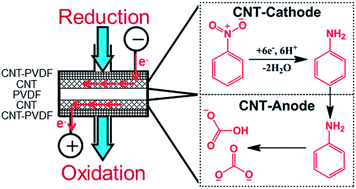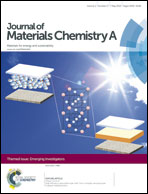CNT–PVDF composite flow-through electrode for single-pass sequential reduction–oxidation†
Abstract
In this study, a five-layer electrochemical CNT–PVDF filter that is thin, flexible, and stable is demonstrated to be effective and efficient for single-pass nitrobenzene mineralization by sequential reduction–oxidation. Key to the technology is development of a CNT–PVDF membrane that is mechanically stable, electrically conductive, and non-Faradaic, which is used to prevent CNT release from and electrochemical degradation of the Faradaic CNT electrodes. A five-layer electrochemical filter: (1) conductive & protective CNT–PVDF, (2) Faradaic CNT electrode, (3) insulating PVDF separator, (4) Faradaic CNT electrode, and (5) conductive & protective CNT–PVDF is formed by mechanical press. At a total cell potential of 4 V, the sequential electrochemical reduction–oxidation process is able to reduce >99% of the influent nitrobenzene to aniline then oxidize >80% of the aniline to non-aromatic products (mostly carbon dioxide) in a single-pass (∼5 s hydraulic residence time). The mineralization current efficiency is ∼20%, total cell potential is completely (>99%) distributed to the two electrodes, and the energy requirement is ∼36 000 kJ per mole of nitrobenzene degraded.

- This article is part of the themed collection: Emerging Investigators

 Please wait while we load your content...
Please wait while we load your content...